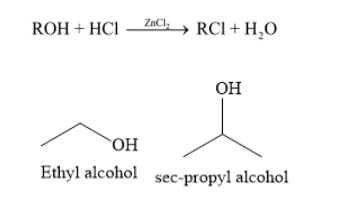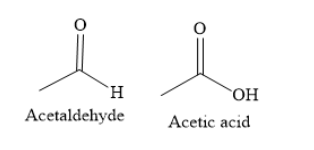
Answer
439.5k+ views
Hint: (i) We can select a reagent that reacts at different rates with primary and secondary alcohols. That test will provide the required difference.
(ii)We have to select a reagent that precipitates with one compound but does not react with another compound.
Complete Step by step answer: (i) Ethyl alcohol is a primary alcohol and sec-propyl alcohol is a secondary alcohol. To distinguish ethyl alcohol and sec-propyl alcohol, you can carry out Lucas test. Lucas test is used to distinguish between primary, secondary and tertiary alcohols. Lucas reagent is a mixture of concentric hydrochloric acid and anhydrous zinc chloride. At room temperature ethyl alcohol (a primary alcohol) does not form any turbidity with Lucas reagent.
Sec-propyl alcohol (a secondary alcohol) forms any turbidity with Lucas reagent within 5-10 minutes.
Lucas reagent converts an alcohol to alkyl halide. The turbidity formed during Lucas test is due to formation of alkyl halide.

(ii) To distinguish acetaldehyde and acetic acid you can use a silver mirror test.
You can use Tollen’s reagent to carry out a silver mirror test. The Tollen’s reagent is an ammoniacal silver nitrate solution. In the presence of Tollen’s reagent, acetaldehyde is oxidized to acetate ion. Silver nitrate is reduced to silver metal. A black ring of silver is formed in the test tube. This black ring is called a silver mirror.
Acetic acid does not react with Tollen’s reagent.

Note: It is possible to distinguish two compounds by using appropriate reagent. This is possible because two compounds contain different functional groups that react differently with appropriate reagent.
(ii)We have to select a reagent that precipitates with one compound but does not react with another compound.
Complete Step by step answer: (i) Ethyl alcohol is a primary alcohol and sec-propyl alcohol is a secondary alcohol. To distinguish ethyl alcohol and sec-propyl alcohol, you can carry out Lucas test. Lucas test is used to distinguish between primary, secondary and tertiary alcohols. Lucas reagent is a mixture of concentric hydrochloric acid and anhydrous zinc chloride. At room temperature ethyl alcohol (a primary alcohol) does not form any turbidity with Lucas reagent.
Sec-propyl alcohol (a secondary alcohol) forms any turbidity with Lucas reagent within 5-10 minutes.
Lucas reagent converts an alcohol to alkyl halide. The turbidity formed during Lucas test is due to formation of alkyl halide.

(ii) To distinguish acetaldehyde and acetic acid you can use a silver mirror test.
You can use Tollen’s reagent to carry out a silver mirror test. The Tollen’s reagent is an ammoniacal silver nitrate solution. In the presence of Tollen’s reagent, acetaldehyde is oxidized to acetate ion. Silver nitrate is reduced to silver metal. A black ring of silver is formed in the test tube. This black ring is called a silver mirror.
Acetic acid does not react with Tollen’s reagent.

Note: It is possible to distinguish two compounds by using appropriate reagent. This is possible because two compounds contain different functional groups that react differently with appropriate reagent.
Recently Updated Pages
Who among the following was the religious guru of class 7 social science CBSE

what is the correct chronological order of the following class 10 social science CBSE

Which of the following was not the actual cause for class 10 social science CBSE

Which of the following statements is not correct A class 10 social science CBSE

Which of the following leaders was not present in the class 10 social science CBSE

Garampani Sanctuary is located at A Diphu Assam B Gangtok class 10 social science CBSE

Trending doubts
A rainbow has circular shape because A The earth is class 11 physics CBSE

Which are the Top 10 Largest Countries of the World?

Fill the blanks with the suitable prepositions 1 The class 9 english CBSE

What was the Metternich system and how did it provide class 11 social science CBSE

How do you graph the function fx 4x class 9 maths CBSE

Give 10 examples for herbs , shrubs , climbers , creepers

The Equation xxx + 2 is Satisfied when x is Equal to Class 10 Maths

What is BLO What is the full form of BLO class 8 social science CBSE

Change the following sentences into negative and interrogative class 10 english CBSE




